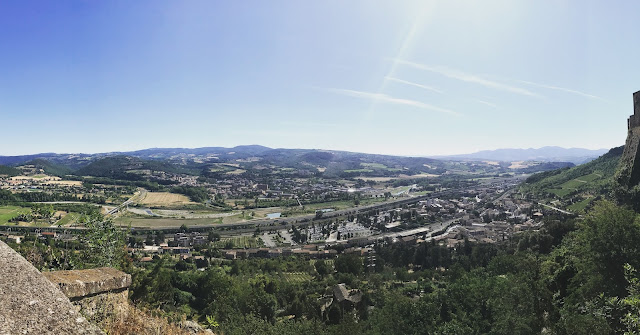Week 1: Getting Settled and Diving In
(Due to having to figure out some blogging technicalities, this post is a week late. But better late than never: here's my take on our first week in Orvieto)
Ciao! Saluti da Orvieto!
View from the clifftop of Orvieto
Today marks the end of week one of ART in Orvieto 2017, and it’s been a week of both getting settled and diving right in.
Orvieto itself is a clifftop town in Italy’s Umbria region. There is evidence of a prominent city existing here since the Etruscan period, and remains of an Etruscan necropolis stand at the base of the cliffs. So Orvieto has long been a notable town, but it rose to prominence in the 1260s when Pope Urban IV commissioned a magnificent cathedral and papal palace to be built in the town following the occurrence of a miracle.
Side and facade of Orvieto's duomo
The story goes that at that time in the nearby city of Bolsena, a priest was presiding over the Eucharist when blood began dripping from the host and onto the altar cloth, attesting to the real presence of Christ in the sacrament. Today, Orvieto lives its history proudly, drawing numbers of visitors to the stories within its walls. In fact, the day the program’s participants arrived in Orvieto was actually the day of Corpus Domini (or Corpus Christi) instituted by Pope Urban IV as a feast day in celebration of this miracle, which has also become a celebration of the founding of the town. Orvieto celebrates this feast day with a town-wide procession of religious regalia through the streets into the cathedral, and a day-long medieval style fair. We arrived and were dropped right into the midst of the town’s most significant story.
Such a setting offers ample sources of inspiration for our studies and artistic projects. Students in this year’s program are a mix of artists, philosophers, historians, and theologians all asking questions around the practice and theory of the image as it gets worked out in Catholic, Orthodox, and Protestant religious traditions. And we’re asking--each from our own standpoints of making, thinking, and doing--what it means to make sense of these things here.
4th century mosaics inside the basilica of Santa Pudenziana in Rome
What’s become apparent to me being here in Italy is the sedimentation of history, ideas, and art--how centuries of people living life together can build one upon another: tearing down, filling in, taking up and changing, imitating, or reacting against things that have come before. In places like Orvieto and Rome (the locale of our first day trip which provided a number of examples of Christian iconography from early Roman to Baroque periods), these sedimented layers exist side by side, forcing us to try to make sense of them. A two-thousand year old temple is surrounded by forty year-old apartment buildings. Brand new cars drive down ancient Roman roads. A single location can be the site of a 1st century house, a 4th century mithraeum and Christian church, an 12th century basilica, and a thriving contemporary congregation. How can these things coexist in a vibrant way, shaping lives here and now? Or can they only ever be vestiges of the past?
Remains of a 1st century Roman house church under the basilica of San Clemente in Rome
Modern streets surrounding the 1st century Coliseum in Rome
Reading about the great deeds of Septimus Severus on his 3rd century arch
It can be easy in the modern world to see only a film of forgetfulness atop the layers of humanity that precede us--to consider such things solidly in the past and therefore not of immediate concern to us even if we may find them interesting. Studying here in Orvieto, though, seems an opportunity to become attuned to how we might peel back that top layer of forgetfulness to see the ways in which these histories, ideas, and artworks relate, and the ways in which they might be alive today. To come back to our specific question of images: to use or not to use is not the only question. Rather, we must understand why they were ever used, how they were seen, and how or what they might help us to see.
Interior of Zeno's Chapel in the basilica of Santa Prassede in Rome








This comment has been removed by the author.
ReplyDeleteThanks information about Getting Settled and Diving In.
ReplyDeleteAdhitya Nugraha Novianta